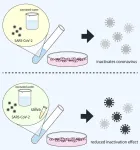(Press-News.org) *EMBARGOED FOR RELEASE UNTIL MONDAY, FEB. 3, AT 5 A.M. ET*
Researchers at the Johns Hopkins Kimmel Cancer Center and Bloomberg~Kimmel Institute for Cancer Immunotherapy have developed a computer model to help scientists identify tumor-fighting immune cells in patients with lung cancer treated with immune checkpoint inhibitors.
In their study published Feb. 3 in Nature Communications, the team, including first author Zhen Zeng, Ph.D., a bioinformatics research associate at the Kimmel Cancer Center, demonstrated that their three-gene “MANAscore” computer model can identify the immune-cells targeted by immune checkpoint inhibitor therapies. It also helped the team identify differences associated with patient response to immunotherapy.
“We have developed a way to identify the cells directly targeted by immune checkpoint inhibitors, and if we can identify them, we can study them,” says the study’s senior author, Kellie Smith, Ph.D., an associate professor of oncology at Johns Hopkins. “If we can study them, that means we can identify better biomarkers and better targets for combination immunotherapy.”
Immune checkpoint inhibitors like PD-1 inhibitors are available to treat dozens of cancer types. These revolutionary therapies work by unleashing tumor-killing immune cells, called T cells, that are switched off by the protein PD-1. PD-1 inhibitors turn the patient’s T cells back on, allowing patients’ immune systems to fight cancer more effectively. But not all patients respond to these therapies, and scientists need to know why in order to develop improved therapies that help nonresponders.
“Tumor-active T cells are very important to a patient’s response to therapy, but they are difficult to find,” Zeng says.
Smith helped develop the MANAFEST technology (Mutation-Associated NeoAntigen Functional Expansion of Specific T Cells), which she and colleagues first described in the journal Cancer Immunology Research in 2018. Their approach combined MANAFEST with single-cell sequencing to identify these rare immune cells in six patients with lung cancer, a laborious process that took several years and cost millions of dollars. The original study showed that the immunotherapy-activated immune cells share a common gene expression profile. In the new study, Zeng, Smith and their colleagues built on those discoveries to develop MANAscore.
“Our model allows us to skip a time-consuming and expensive process to identify the cells targeted by immunotherapy, and will help us identify what distinguishes who will respond to these therapies,” Smith says. “We’re not the first to come up with one of these models, but what sets ours apart is that it uses only three genes, while the most commonly used model requires more than 200 genes. Ours is simpler and easier to use.”
The team also found key differences in the T cells activated in the tumors of patients who respond to immune checkpoint therapy compared with those who don’t. Responding patients exhibit a higher proportion of stem-like memory T cells, which act as a reservoir for new cells and can develop into many effective anti-tumor cells, Zeng says. This observation may help explain why patients are more able to respond; the stem-like characteristics may make it easier for the T cells to multiply into an army of tumor-fighting cells. More studies are needed to confirm these observations.
“The stem-like characteristics of T cells are critical because they enable self-renewal and long-term persistence,” Zeng says. “This allows for sustained immune responses and the ability to expand into a robust population of effector T cells when needed.”
In the meantime, the team is working to develop a clinical test that uses multispectral immunofluorescence panels to identify the three-gene signature of immune therapy responding T cells.
“We hope to translate our three-gene signature into a biomarker that clinicians can use to guide cancer care,” Smith says.
Zeng is also using their new model to determine whether the proximity of T cells with the three-gene signature to other types of immune cells, like regulatory T cells, helps control the immune response.
“We want to apply our model to spatial data to learn whether cell-to-cell interactions among tumor-targeting T cells and other cell types affect clinical outcomes,” Zeng says.
She is also collaborating with other laboratories across the country to determine if MANAscore can be used in patients with different types of cancer. They’ve created a database of single-cell sequencing data across cancer types and will use the score to help identify cancer-type-specific responder T cell characteristics.
Other researchers who contributed to the study include Tianbei Zhang, Shuai Li, Sydney Connor, Boyang Zhang, Jordan Wilson, Dipika Singh, Suzanne L. Topalian, Patrick M. Forde, Drew M. Pardoll and Hongkai Ji of Johns Hopkins. Jiajia Zhang of the David Geffen School of Medicine, University of California, Los Angeles; and Yimin Zhao, Rima Kulikauskas, Candice D. Church, Thomas H. Pulliam, Saumya Jani and Paul Nghiem of the Fred Hutchinson Cancer Center and the University of Washington in Seattle also contributed to the research.
The work was supported by The Mark Foundation for Cancer Research, the Bloomberg~Kimmel Institute for Cancer Immunotherapy, The Mark Foundation Center for Advanced Genomics and Imaging, the Cancer Research Institute, the Lung Cancer Foundation of America, LUNGevity, the American Lung Association, Swim Across
America, the Commonwealth Foundation, Bristol Myers Squibb, the National Institutes of Health, Kelsey Dickson Team Science Courage Research Award: Advancing New Therapies for Merkel Cell Carcinoma, the MCC Patient Gift Fund and the National Foundation for Cancer Research.
Forde receives research support from AstraZeneca, BioNtech, Bristol Myers Squibb, Novartis and Regeneron; has been a consultant for AstraZeneca, Amgen, Bristol Myers Squibb, Iteos, Novartis, Star, Surface, Genentech, G1, Sanofi, Daiichi, Regeneron, Tavotek, VBL Therapeutics, Sankyo and Janssen; and serves on a data safety and monitoring board for Polaris. Smith and Pardoll have filed for patent protection on the MANAFEST technology (serial No. 16/341,862). Pardoll is a consultant for Compugen, Shattuck Labs, WindMIL, Tempest, Immunai, Bristol Myers Squibb, Amgen, Janssen, Astellas, Rockspring Capital, Immunomic and Dracen; owns founders’ equity in Clasp Therapeutics, WindMIL, Trex, Jounce, Enara, Tizona, Tieza and RAPT; and receives research funding from Compugen, Bristol Myers Squibb and Enara. Smith has received travel support/honoraria from Illumina Inc.; receives research funding from Bristol Myers Squibb, AbbVie and Astra Zeneca; and owns founder’s equity in Clasp Therapeutics. Topalian receives consulting fees from Bristol Myers Squibb, Dragonfly Therapeutics, PathAI and Regeneron; receives research grants from Bristol Myers Squibb; has stock options in Dragonfly Therapeutics; and has a patent related to the treatment of MSI-high cancers with anti-PD-1. These relationships are managed by The Johns Hopkins University in accordance with its conflict-of-interest policies.
END
Computer model helps identify cancer-fighting immune cells key to immunotherapy
2025-02-03
ELSE PRESS RELEASES FROM THIS DATE:
Keeper or corner?
2025-02-03
Our brain is remarkably flexible in producing different reactions to supposedly comparable situations. The same sensory information can lead to different decisions depending on the behavioral context. One example of this is a penalty kick in soccer: a player can either choose the empty corner of the goal as the target or aim directly at the goalkeeper in the hope that he will jump aside. Both decisions are based on the same perception of the goalkeeper's position, but lead to completely different actions. Neuroscientists at the German Primate Center (DPZ) - Leibniz Institute for Primate Research in Göttingen have investigated how the brain implements this ...
Printable molecule-selective nanoparticles enable mass production of wearable biosensors
2025-02-03
The future of medicine may very well lie in the personalization of health care—knowing exactly what an individual needs and then delivering just the right mix of nutrients, metabolites, and medications, if necessary, to stabilize and improve their condition. To make this possible, physicians first need a way to continuously measure and monitor certain biomarkers of health.
To that end, a team of Caltech engineers has developed a technique for inkjet printing arrays of special nanoparticles that enables the mass production of long-lasting wearable sweat sensors. These sensors could be used to monitor a variety of biomarkers, ...
Mapping the yerba mate genome reveals surprising facts about the evolution of caffeine
2025-02-03
Yerba mate, along with tea and coffee, is one of the world’s most popular caffeinated beverages. Widely consumed in South America, this remarkable plant is rich in diverse, bioactive compounds that contribute many health benefits.
An international group of researchers has mapped the yerba mate genome, providing insights into the biosynthesis of caffeine in yerba mate. This new information provides opportunities for creating plant varieties with new characteristics.
The work, led by the ...
Electricity prices across Europe to stabilise if 2030 targets for renewable energy are met, study suggests
2025-02-03
Hitting the current national 2030 quotas for solar and wind energy could reduce the volatility of electricity markets by an average of 20% across 29 European countries, according to a new study from the University of Cambridge.
The intensity of spikes in power prices are predicted to fall in every country by the end of the decade if commitments to green energy are met, as natural gas dependency is cut.
The UK and Ireland would be the biggest beneficiaries, with 44% and 43% reductions in the severity of electricity price spikes by 2030, compared with last year.
Germany could experience a 31% decline in electricity price ...
Improved treatment timing reduces honey bee losses to Varroa mites
2025-02-03
Honey bee mortality can be significantly reduced by ensuring that treatments for the parasitic Varroa mite occur within specific timeframes, a new study reveals.
The mites—belonging to the species Varroa destructor—feed on the larvae of bees and can destroy colonies if not treated at key points to reduce or remove infestations.
But researchers have found that more than a third of beekeepers surveyed in England and Wales deviate from recommended treatment guidelines, including application windows.
Crucially, they found that beekeepers who mistimed Varroa mite treatments experienced exacerbated colony losses, with the effect occurring ...
CAR-T cells can arm bystander T cells with CAR molecules via trogocytosis
2025-02-03
Engineered immune cells called CAR-T cells are used in the treatment of cancer. Researchers from Uppsala University have now discovered that CAR molecules can be transferred from the CAR-T cells to other T cells in the tumour microenvironment. The researchers also pinpoint how this transfer is regulated, which may be used to improve the efficacy of CAR-T cell therapy. The study has been published in the journal Science Immunology.
Immune cells have a capacity to exchange cell surface molecules between one another. This exchange is called trogocytosis and may potentially impact the immune response since it allows different proteins to be transferred between cells.
Chimeric antigen ...
Can ocean-floor mining oversights help us regulate space debris and mining on the Moon?
2025-02-03
by Nishith Mishra, Martina Elia Vitoloni, and Dr Joseph Pelton
Mining ocean resources needed for electric cars and other devices is currently a hot issue of dispute. Final resolution of how or whether the seabed should be expl18oited is pending. Outcomes in this contentious area could create precedents that could impact decisions about mining the moon.
These precedents might shape the how and why of mining the Moon and shape the future and the sustainability of space activities of human beings. But this is only one possible precedent that could reshape the future of space.
Pending international discussions on space traffic management, space debris removal, and limiting ...
Observing ozonated water’s effectiveness against SARS-CoV-2 in saliva
2025-02-03
Disinfecting surfaces is crucial in keeping bacteria and viruses at bay, but the cleaning solutions could be ineffective if met with neutralizing compounds.
Ozonated water has a strong disinfection effect on mold and bacteria, and is also shown to work on SARS-CoV-2, which is responsible for COVID-19. The downside is that ozonated water breaks down quickly in the presence of organic matter, which reduces its effectiveness. SARS-CoV-2 is transmitted through droplets mixed with bodily fluids, such as saliva and nasal mucus which contain organic matters. For this reason, it is necessary to investigate how effective ozonated water is in the presence of ...
Alcohol-related deaths up 18% during pandemic
2025-02-03
Alcohol-related deaths increased 18% during the pandemic, as did hospitalizations related to alcohol use, according to new research in CMAJ (Canadian Medical Association Journal) https://www.cmaj.ca/lookup/doi/10.1503/cmaj.241146.
In the early part of the pandemic, retail alcohol sales volume in Canada increased by 2% (2020/21 v. 2019), the highest increase in 10 years, despite few international visitors. More than 1 in 4 people (26%) reported drinking more, and 18% reported heavy drinking (defined as ...
Mothers of twins face a higher risk of heart disease in the year after birth
2025-02-03
The risk of being admitted to the hospital with heart disease is twice as high the year after birth for mothers of twins compared to singleton births, according to research published in the European Heart Journal [1] today (Monday). The risk is even higher in mothers of twins who had a high blood pressure condition during pregnancy.
The research was led by Professor Cande Ananth from the Department of obstetrics, gynecology, and reproductive sciences at Rutgers Robert Wood Johnson Medical School, New Jersey, USA.
He said: “The rate of twin pregnancies worldwide ...




